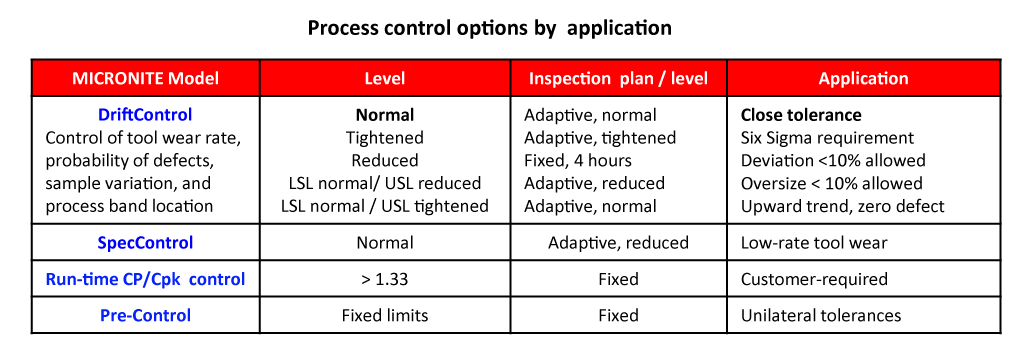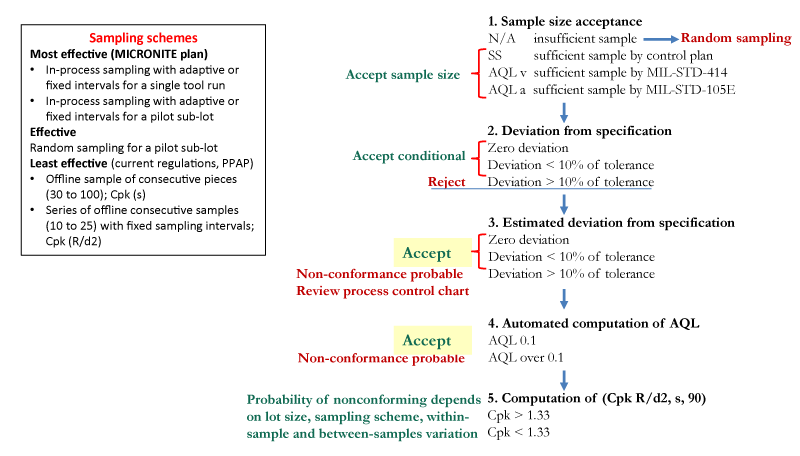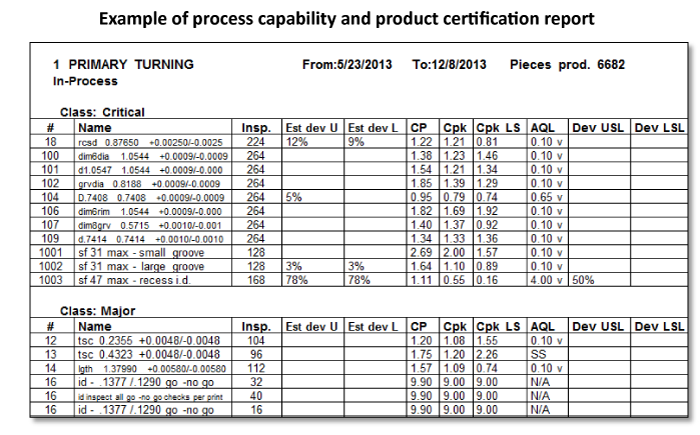A remarkable advantage of a tool-based process control framework
Only MICRONITE presents a comprehensive, fully integrated tool-based framework that addresses the user’s evolving needs in predictive tool life control and the statistical knowledge of tool life and failure modes. A single unit of the predictive tool life model is framed between adjustments (offsets) or tool changes. Each model is built by statistical estimates, algorithms, and decision-making rules. Multi-variate static and dynamic models are used for control of complex tool paths and form tools. Tooling data is used to support machining process design, optimize cycle time, and train operators in technological know how. A tool life database is uniquely compiled by MICRONITE using automatic machine on/off function and identification of roughing and finishing tools for each operation. A tool life and failure mode record is automatically stored in the database along with inspection records. This makes it easier to share consistent, holistic views of the machining process and enhances decision-making abilities of MICRONITE’s expert system. A remarkable advantage of tool-based MICRONITE is a system-guided help with a substantial increase of throughput and productivity.
Use inspection data for MICRONITE’s assessment and decisions on cumulative capability of CNC machine, gages, fixtures, and tooling. You get a clear guide to process improvement and engineering problem solving.
• Gather all the right process data-across machines, cutting tools, part numbers, work orders, shifts, etc.
• Gain complete visibility into how processes are performing at every step of production run so you’ll know what’s in control – and what isn’t.
• Achieve process control effectiveness by elimination of non-productive labor and time
• Quantify machine-specific causes of variation and shifts
• Establish procedures for in-process and offline control of multi-fixture and multi-spindle machines
• Leverage shop-floor inspection data for improvement of tool capability to hold tolerance
• Step up the use of inspection data for reduction of cycle time
• Bridge the process and quality gap connecting inspection and tooling data
The software performance and effectiveness depends on achieving the obvious goal of assuring the absolute accuracy of measurements and non-conventional purpose of attaining the ability to recognize dynamic mechanisms of the machining process. The MICRONITE approach for process control is different from that used by statistical software packages. MICRONITE has three major focuses. First, a variety of models are employed for real-time and off-line data analysis. An assurance of extremely low risk quality acceptance and process control errors is absolutely necessary to benefit from massive amounts of data. Second, MICRONITE addresses the needs of a tool-centered control of the machining process. Along with grouping of characteristics by finishing tools, the system will determine the capability of form and single-point tools needed to hold multiple tolerances. Third, measuring and machining metrology is included into the knowledge-based control system. There is significant consideration of measuring errors and form variation that would be worst for the ability to correctly certify product quality and provide preventive zero-defect process control. The outcome is a broad-based plan for the best utilization of modern equipment.
Characteristics of typical machining process
- Non-uniformity of tool wear
- location of wear spot on the cutting edge
- size and depth of wear spot
- transitional wear rate from steady-state to accelerated
- Non-repeatable tool wear patterns for identical tools
- High sensitivity of tight-tolerance machining to thermal instability and temperature spikes on the cutting edge
- Types of correlation between tool wear progress and size of dimensional characteristics from strong to weak to no correlation
- Non-linear dynamics of dimensional size changes
- Types of correlation between tool wear and sample range from strong to weak to no correlation
- Instability of the sample range in case of close-tolerance in-process inspection
- Leading effect of tool wear either on size of dimensional characteristic or the sample range
- Misalignment between tool-associated characteristics
- Majority of machining processes are shifted relative to specification nominal and successfully running in a state which is out-of-statistical control
Read process insights with details inaccessible in SPC and general statistical software
Process control effectiveness is the manufacturing intelligence application for managing real-time decision-making on the exact time it takes to inspect parts, offset or change a tool, and notify quality and process engineers about arising or unresolved problems. MICRONITE pioneers predictive and process-adaptive AI-based analytics which include tool-wear simulation and computation of the dynamic probability of non-conformance to specification. This technique makes it easy for a company to leverage shop-floor inspection data for error-proof decisions all the time, on the process actions. MICRONITE’s machining data visualizer shows operators and technical staff how data drives tool-and-quality control to comply with it’s statistical quality requirements. At a glance, the user can see the relationships among tool-associated characteristics and situations that require some process actions, correction of NC-code, or tool re-design. Smart MICRONITE interface streamlines the definition of common process functions such as re-inspection, tool offset, tool change, or change of process parameters. MICRONITE predictive models demonstrate heightened process accuracy and reliability and lower defect occurrence gained from error-proof tool wear simulation. A variety of predictive models lead to flexibility to innovate by way of faster and less costly experimentation on the shop floor. Designers of MICRONITE have encouraged the industry to face the growing reality of controlling extremely close tolerances and certifying quality with a low risk of acceptance errors. Using MICRONITE, process engineers decidedly change the expensive Product Launch that meant spending endless weeks and months contemplating the perfect process, which may or may not be achieved using limited analytical resources. Today’s machine shops need to engage process and quality engineers across all diagnostic, control, and optimization channels offered by MICRONITE. They need intelligent automation on the shop floor and in the office, with a technical service suite with dynamic management to support the effective production system.
Focus on process details
The software performance and effectiveness depends on achieving the obvious goal of assuring the absolute accuracy of measurements and non-conventional purpose of attaining the ability to recognize dynamic mechanisms of machining process. The MICRONITE approach for process control is different from that used by statistical software packages. MICRONITE has three major focuses. First, a variety of models are employed for real-time and off-line data analysis. Assurance of extremely low risk of quality acceptance and process control errors is absolutely necessary to benefit from massive amount of data. Second, MICRONITE addresses the needs of tool-centered control of machining process. Along with grouping of characteristics by finishing tools, the system determine the capability of form and single-point tools to hold multiple tolerances. Third, measuring and machining metrology is included into the knowledge-based control system. There is significant consideration of measuring errors and form variation that would be worst for the ability to correctly certify product quality and provide preventive zero-defect process control. The outcome is a broad-based plan for the best utilization of modern equipment.
Combination of elements recognized by MICRONITE’s model for actions decision
• Process recognition with isolation of last phase
• Tool wear simulation and wear rate computation
• Analysis of dynamic changes in variation
• Probability of defects before next inspection
Quality-related capability of machining process and product certification in a single format
Regulatory capability studies are frequently misleading engineers in assessment of process capability. Most effective method of assessment is the ability to accurately predict dimensional failures before they occur, while running a process at peak performance. MICRONITE solutions provide a broad scope of analytical and predictive capabilities to give the user better knowledge about potential capability to meet the quality specification.
The momentum coming from MICRONITE has lifted the importance of close-tolerance process quality assessment. MICRONITE becomes the versatile tool to solve most challenging problems in quality assurance and process capability fields ranging from small batch to high-volume production. The system includes virtually every data segment (shift, sub-lot, lot), distributional and non-distributional statistical estimates, and summary reports that quality and process engineers could ever need.





